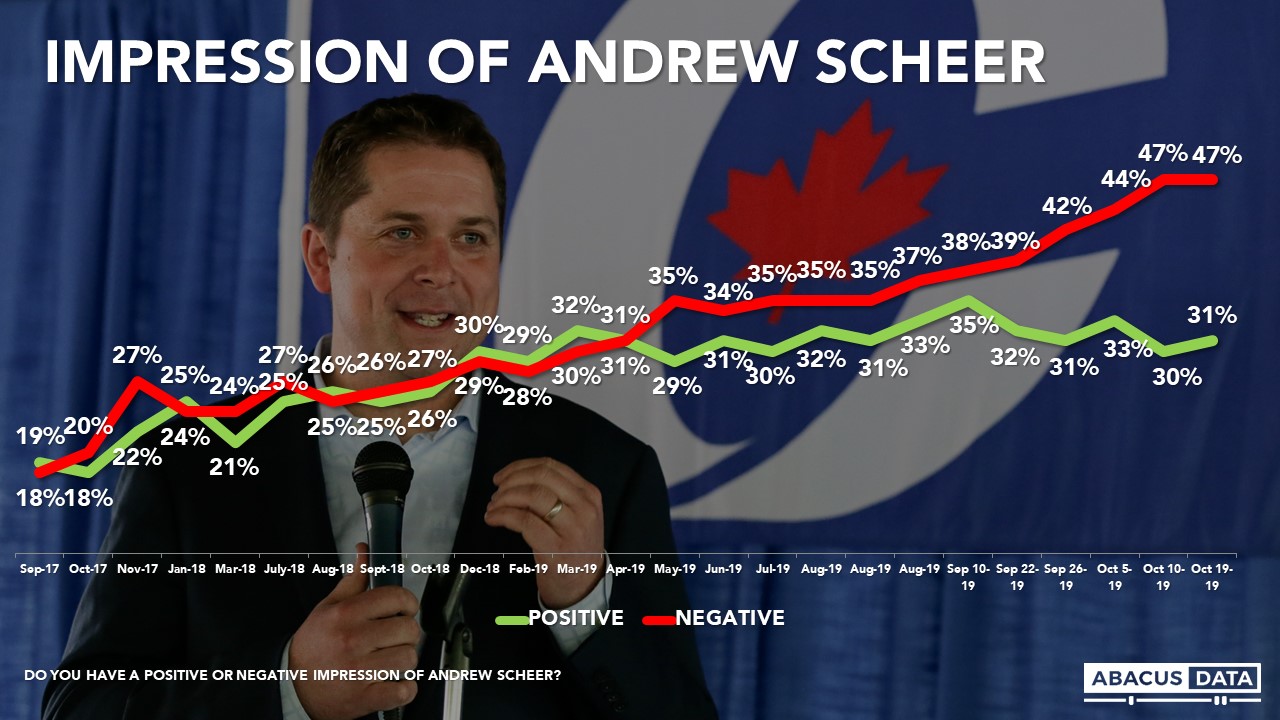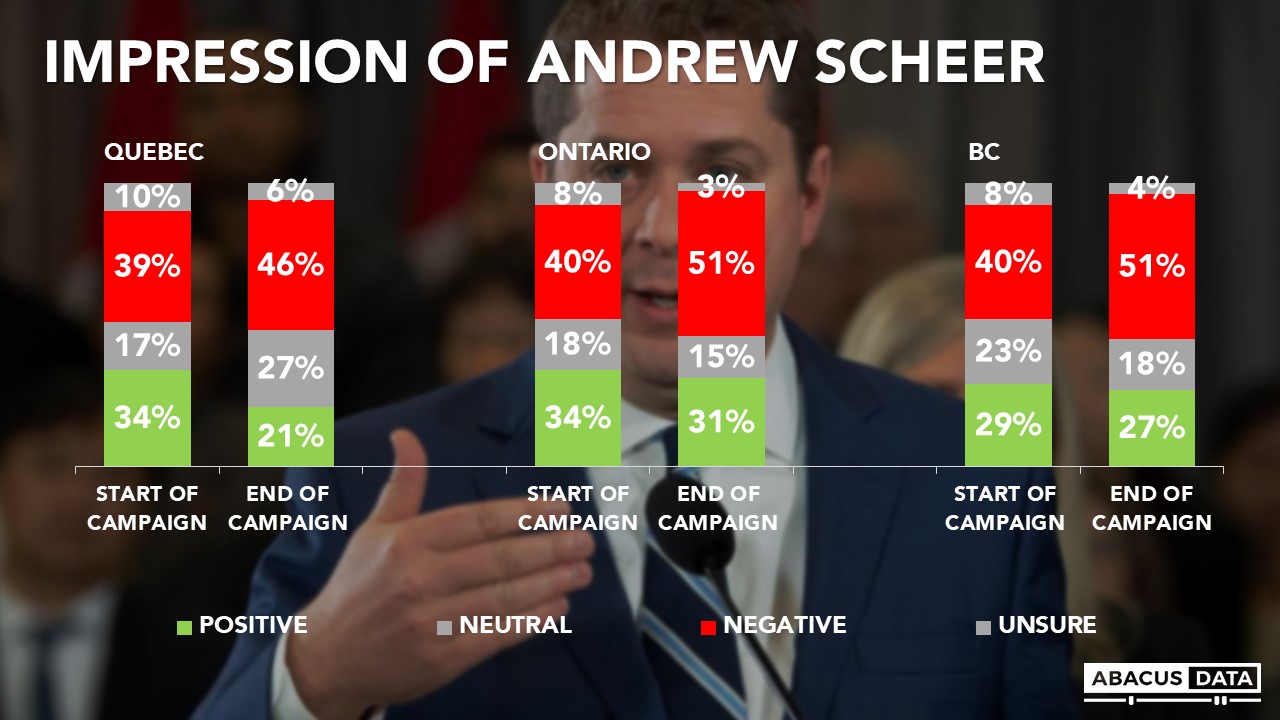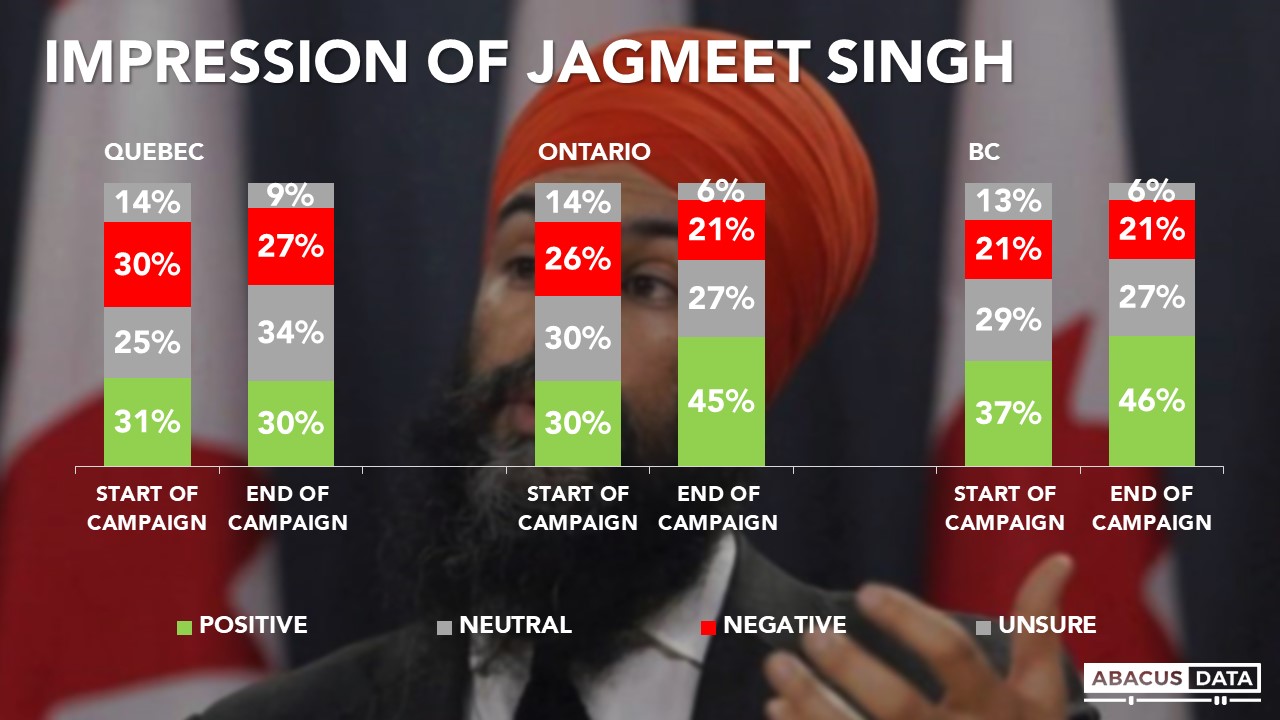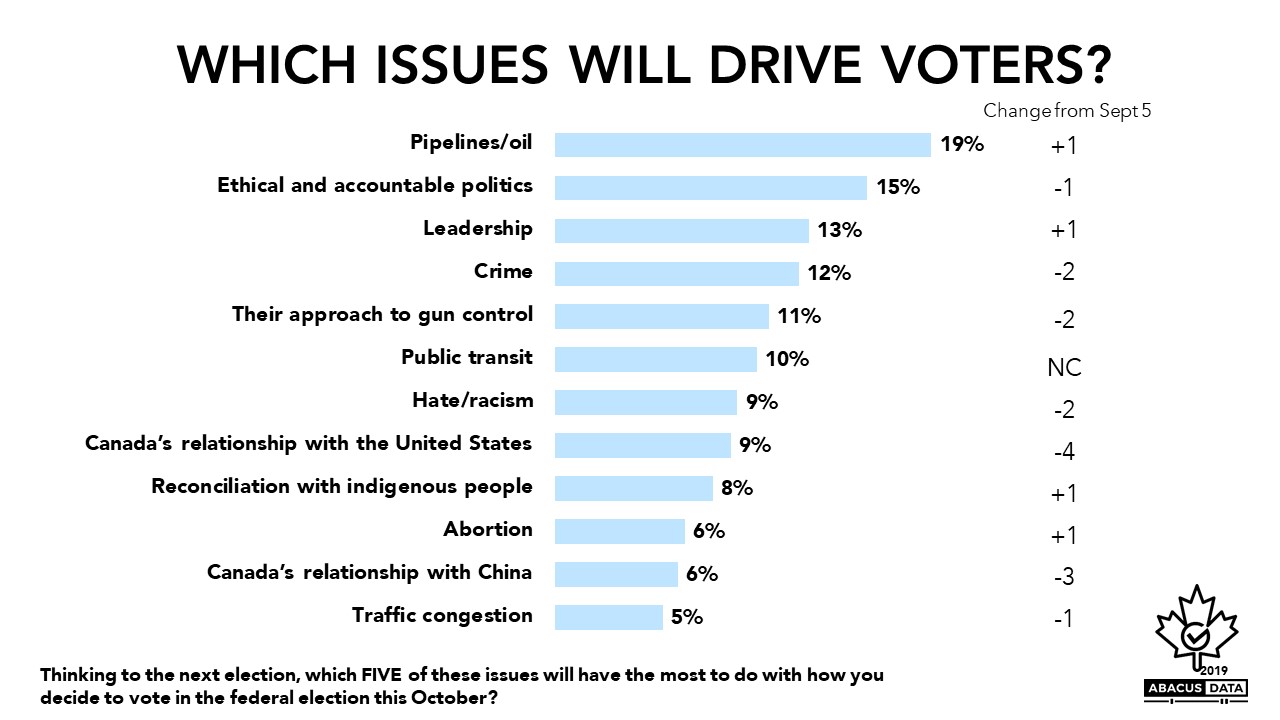Election Poll: Regional races & turnout will decide an election with 2-points separating Liberals and Conservatives in Canada
October 20, 2019
Yesterday, we completed our final survey of Election 43, interviewing 2,000 Canadians from Thursday to Saturday. Here is our take on Canadian public opinion as polling stations are set to open tomorrow morning.
THE MOOD OF THE COUNTRY
In 2015, 60% of Canadians said they definitely wanted a change in government, and this translated into a win for the Liberal Party. At the start of the 2019 campaign, 51% said they definitely wanted a change in government. At the end of the campaign, those numbers are basically unchanged.

Regionally, since the start of the campaign, the desire for change in Quebec has dropped, it has held steady in Ontario, while rising 9-points in BC. The desire to see the Liberals re-elected has stayed consistent in all three of the largest provinces.

LEADERS: SINGH ENDS CAMPAIGN WITH THE BEST IMAGE BUT DOUBTS ABOUT WHETHER IT WILL PRODUCE SEATS; SCHEER’S IMAGE SUFFERS OVER CAMPAIGN
NDP Leader Jagmeet Singh ends the campaign with the most favourable image: 40% positive and 24% negative. Since the campaign began, his favourables are up 15-points.

Mr. Trudeau’s personal numbers have stayed relatively stable and improved slightly in the final days of the campaign, with a 5-point increase in his positives since last week.
Mr. Scheer’s negatives have more than doubled throughout the campaign. For much of this year, the Conservative leader had a reputation advantage over Mr. Trudeau, now the reverse is true.
Ms. May has lost ground over the campaign. While she ends the campaign with a net positive impression, her favourables starting the campaign were 33% and have dropped to 27%.



In Quebec, Mr. Blanchet is viewed quite positively. 40% have a positive impression with 24% negative for a positive image of +16.
Max Bernier remains the most unpopular leader in federal politics, by a wide margin.

Regionally, Mr. Trudeau’s image has remained relatively stable in Quebec and BC while improving in Ontario. Mr. Scheer’s image has become more negative across the three largest provinces, with his negatives rising 7-points in Quebec, 9-points in Ontario, and 9-points in BC.


For Mr. Singh, his positives have increased substantially in both Ontario (+15) and BC (+9) since the start of the campaign, while his image in Quebec remains very much where it was at the start of the campaign.

THE ISSUES
When we ask respondents to pick the top 5 issues that will determine their vote, the top most frequently chosen are the cost of living (60%), access to health care (44%), climate change and the environment (42%), taxes (42%), poverty and inequality (29%), and economic plan for Canada’s future (29%). Little has changed in this regard since the beginning of the campaign.
The cost of living (+4), climate change and the environment (+4) and the carbon tax (+7) are the only issues to have shifted outside the margin of error.


Looking specifically at affordability and climate change, the cost of living is a top issue for a majority in every region of the country, across age, gender and partisan groups.
Climate change is more likely to be ranked as a top issue in Quebec (50%), Atlantic Canada (45%), Ontario (43%), and BC (41%) than in Alberta (27%) or Saskatchewan and Manitoba (39%). Those aged 18 to 29 are about 7 to 11 points more likely to rank climate change as a top issue than older Canadians. Women are 9-points more likely than men.



Climate change is also highly partisan. While a majority of Liberal, NDP, Green, and BQ supporters rank it in their top 5 issues, only 20% of Conservative supporters feel the same way.
Among those motivated by the cost of living or climate change as a top issue, we asked whether they felt the Liberals or Conservatives offered the best approach. On the cost of living, the Liberals lead by 8, 54% to 46%. On climate change, the gap is 62 points.


THE ECONOMY
Other than in Alberta, economic conditions do not figure prominently in this election, with 39% describing economic conditions in Canada as good, and another 29% as “acceptable.” While there is some correlation between vote intention and economic perceptions, the relationship is not particularly strong. For example, half of Conservative supporters describe the economy in Canada as good or acceptable.

Locally, we see similar responses. 42% describe the economic conditions where they live as good with another 31% saying acceptable. About one in four say they are poor. Those living in Alberta and Atlantic Canada are more likely to feel negative about the economic conditions while those in Quebec and Ontario are most bullish about the local economy.

CANADIANS THINK THE RESULT WILL BE CLOSE & MORE THINK LIBERALS WILL WIN
Almost all Canadians believe that the election is close, with 46% describing the election as very close and another 48% saying it will be pretty close. Believing the election is close is motivating. Those who think the election won’t be close are the least likely to vote.


In August, 34% thought the Conservatives would win the election, compared to 31% who thought the Liberals would. Today, 41% think the Liberals will win the election compared to 32% who say the Conservatives will.
Liberal voters are slightly more convinced than Conservative voters that their party will win. Among NDP, Green and BQ supporters about 4 in 10 expect a Liberal victory, far more than expect the Conservatives to come out on top. 3 in 10 NDP voters expect their party will win the election.


PREFERRED PM: TRUDEAU LEADS SCHEER BY 6
When asked who they would prefer to as PM after the election, 37% picked Mr. Trudeau (up 2 since the start of the campaign), 31% prefer Mr. Scheer (down one), while 19% prefer Mr. Singh (up 6).

In Ontario, 40% prefer Mr. Trudeau to 30% for Mr. Scheer. In Quebec, Mr. Trudeau has a 14-point lead over Mr. Scheer (47% to 23%). In BC, Mr. Trudeau is ahead of Mr. Singh (35% to 27%) with Mr. Scheer in third at 24%.
THE VOTE: LIBERALS HAVE SLIGHT LEAD NATIONALLY
Combining those who have already voted and those eligible to vote tomorrow, the Liberals (34%) have a slight lead over the Conservatives (32%) nationally followed by the NDP at 16%, the Greens at 8%, and the BQ at 8% (33% in Quebec). Maxime Bernier’s People’s Party registers just 2% support.

In BC, we see a three-way tie with the Liberals at 33%, the Conservatives at 27% and the NDP at 25%. In Ontario, the Liberals have a 6-point lead over the Conservatives (39% to 33%) with the NDP at 19%. In Quebec, the BQ and Liberals are statistically tied with the BQ at 33% and the Liberals at 32%. The Conservatives are at 15%, while the NDP and Greens are both at 8%.

NDP support is strongest among those aged 18 to 29 at 26% and drops to 9% among those aged 60 and over. Liberal support is consistent across age groups, while the Conservatives are stronger among older voters and quite a bit weaker among younger ones.

REACTIONS TO POTENTIAL OUTCOMES
We asked respondents to react to different governing scenarios following the election, asking whether the outcome would be good or bad for Canada.
Overall, no one scenario found a majority saying it would be good for Canada, but the outcomes with the highest positive reaction were the NDP and Liberals governing together (39%), the NDP, Liberals, and Greens governing together (35%), the Conservatives governing alone (35%), and the Liberals governing along (34%).

Notably, the idea of a collaboration between the CPC and the BQ was the least popular scenario. Outside Quebec, a BQ/Conservative collaboration was universally viewed as a bad thing for Canada with 70% in BC, 64% in Alberta, and 65% in Ontario feeling it would be a bad thing for Canada.
Liberals generally thought that any governing arrangement that included the Liberals would be good, except if it included the Conservatives or the BQ.

Similarly, Conservatives liked the idea of the Conservative Party governing alone and didn’t like any other combination. Interesting to note that Conservatives were more open to a collaboration with the NDP than with the Liberals.

NDP supporters were three times more likely to like the idea of a collaboration with the Liberals as one with the Conservatives.

BQ supporters were 8 points more likely to prefer collaboration with progressive parties rather than with the Conservatives.

UPSHOT
According to Bruce Anderson: “A tense political year will finish with a tense election day for Canada’s two largest political parties. The outcome will be a function of unique regional dynamics and which voters are most and least motivated to mark a ballot.
The election was always going to be a challenge for the Liberals, given the year that preceded the writ period. While enthusiasm for the party and Mr. Trudeau is not what it was in 2015, antipathy is muted (outside Alberta), and progressive (Green and NDP voters) prefer a Trudeau government to a Scheer government.
The election campaign has not been a success for the Conservatives in terms of building public confidence in the party’s platform but especially in its leader. Mr. Scheer has lost a lot of ground, while his Liberal rival has held his ground, and perhaps a bit better. After a poor performance in the Quebec debates, Mr. Scheer did not have a breakthrough in the English debate.
If the Conservatives don’t win, our data reveals that Mr. Scheer failed to persuade voters that he was a better choice than Mr. Trudeau on his marquee cost of living issue. He also basically seemed to surrender on climate change.
The performance of Jagmeet Singh on the campaign trail was one of two major surprises. Whether his personal popularity can help produce a better seat count than it looked like the NDP was headed for is an open question with 24 hours to go. The second major surprise has been the rising interest in the Bloc Quebecois. Whether Bloc voters turn out in the numbers reflected in our polling may tell the tale of whether the Liberals or Conservatives win on Monday, and what size of a margin of manoeuvre a new government will have.
According to David Coletto: “The 2019 federal election ends very much as it started with a close race between the Liberals and Conservatives nationally. If these numbers hold until tomorrow night, the Liberals should win more seats and I expect to see a hung parliament as the most likely outcome.
A few final observations as the campaign ends.
First, if the BQ’s rise in Quebec materializes on Monday, it is perhaps the biggest surprise of the campaign. While there was always a chance that the BQ could reassert itself into federal politics, the extent of its rise was unexpected.
Second, while Mr. Singh and the NDP could lose seats on Monday, he’ll be the only federal leader to come out of the campaign stronger than when he entered it. His personal numbers are up substantially, and while the NDP’s share of the vote will likely be below its 2015 tally, Mr. Singh’s performance likely earned him another kick at the can.
While Mr. Scheer could end up becoming Prime Minister if Conservative turnout is stronger than the Liberals, he ends this campaign viewed more negatively than when it started and his net image is more negative than Mr. Trudeau’s. By making the campaign about affordability, the Conservatives sought to campaign on terrain that could unite its base with voters from other parties. To win, the Conservatives needed to gain a big advantage on the question, “Which party will make your life more affordable?” In the end, the 4-point margin it gained over the Liberals does not appear enough to counteract Mr. Scheer’s vulnerability on other issues including his inability to breakthrough in Ontario or Quebec.
For Mr. Trudeau and the Liberals, they entered the campaign vulnerable. The SNC-Lavalin controversy reset the public’s view of both the government and the Prime Minister, and it appears, if the results on Monday match our final poll, that the party hasn’t been able to overcome the damage that controversy had on Mr. Trudeau’s image. While his personal numbers are more positive than they have been in over six months, it appears the Liberals will come up short in rebuilding its 2015 coalition or building a new, more-progressive oriented one in 2019.”
Want to know what Canadian millennials are thinking this election, check out our new analysis of the largest generational cohort in the electorate: https://abacusdata.ca/final-abacus-millennials-elxn43/
METHODOLOGY
Our survey was conducted online with 2,000 Canadians aged 18 and over from October 17 to 19, 2019. A random sample of panellists was invited to complete the survey from a set of partner panels based on the Lucid exchange platform. These partners are double opt-in survey panels, blended to manage out potential skews in the data from a single source.
The margin of error for a comparable probability-based random sample of the same size is +/- 2.1%, 19 times out of 20. The data were weighted according to census data to ensure that the sample matched Canada’s population according to age, gender, educational attainment, and region. Totals may not add up to 100 due to rounding.

ABOUT ABACUS DATA
We are the only research and strategy firm that helps organizations respond to the disruptive risks and opportunities in a world where demographics and technology are changing more quickly than ever.
We are an innovative, fast-growing public opinion and marketing research consultancy. We use the latest technology, sound science, and deep experience to generate top-flight research-based advice to our clients. We offer global research capacity with a strong focus on customer service, attention to detail and exceptional value.
Contact us with any questions.
Find out more about how we can help your organization by downloading our corporate profile and service offering.




